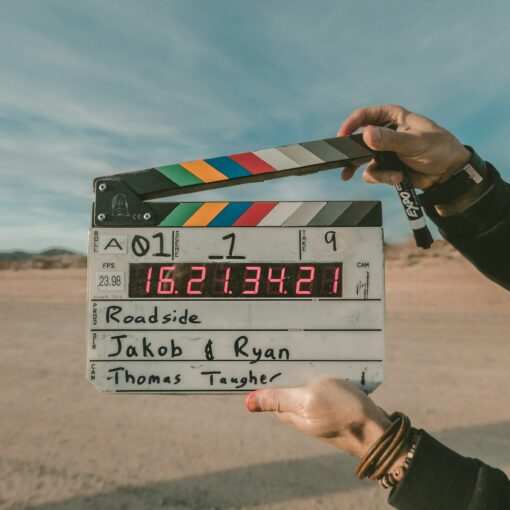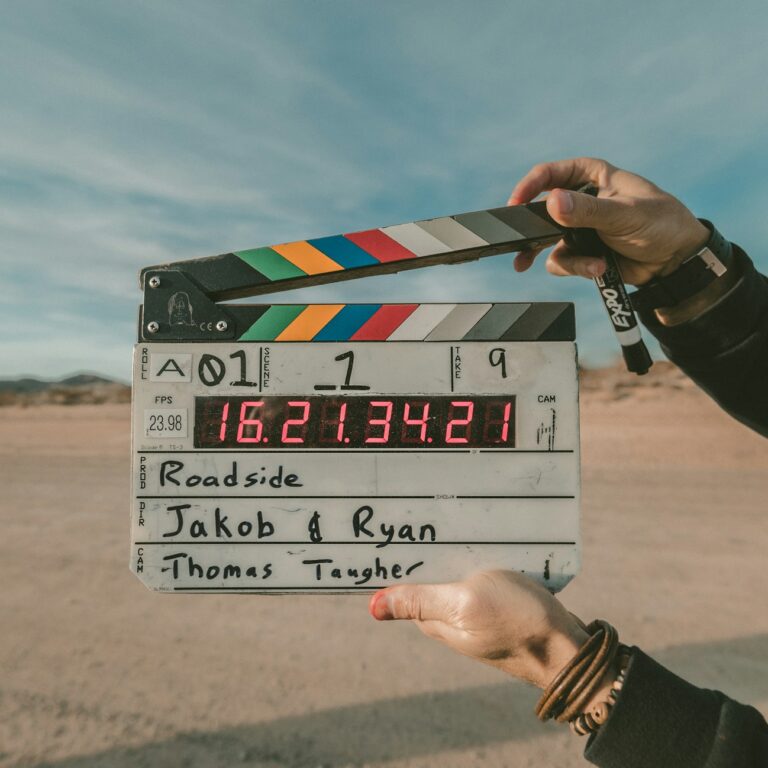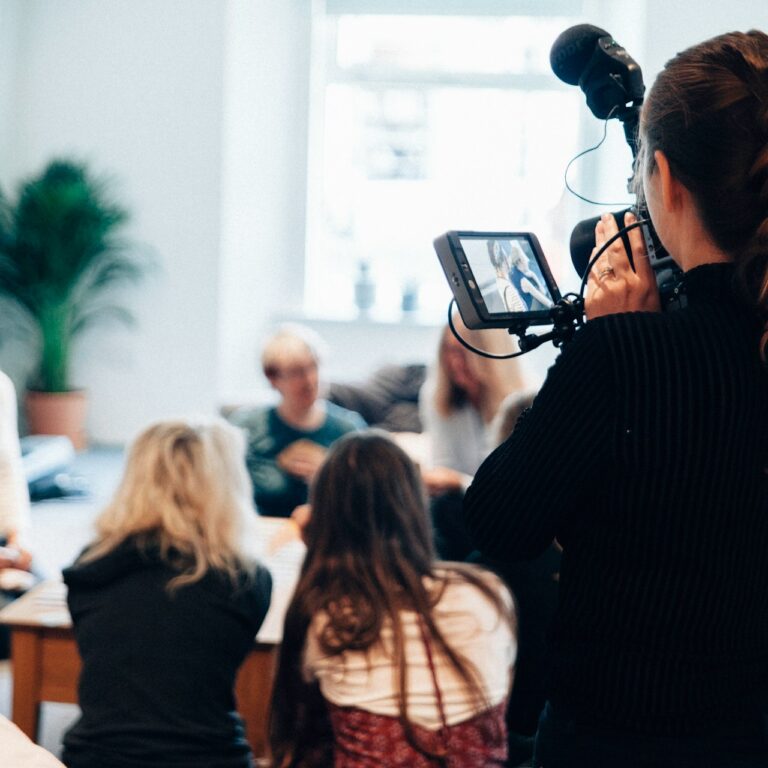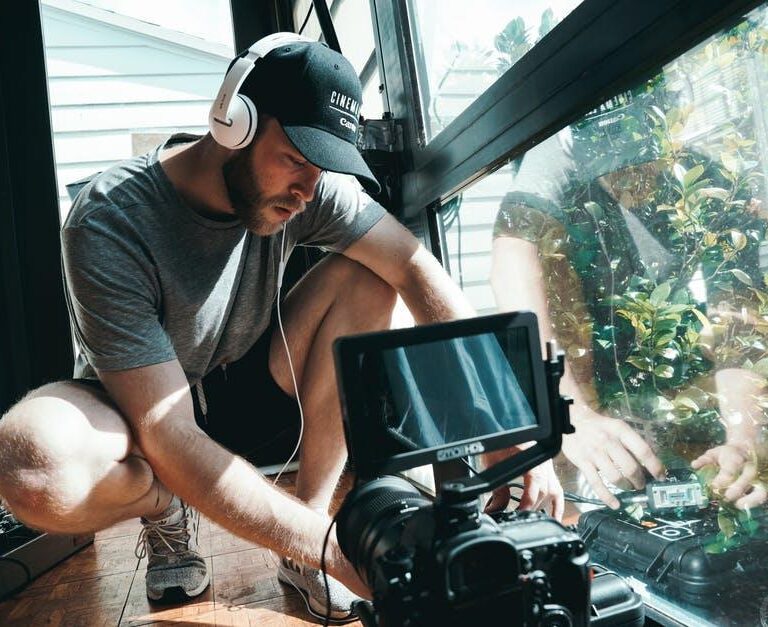Have you ever wondered how videos become…videos? After someone thinks of the idea, what happens after that?
It’s a unique process with lots of moving parts, but one big piece of it is making storyboards for client approval. Your client needs to see the look and feel of the photography and approve the typography you’re going to use.
One does not simply shoot and sell a video. The process is expensive and requires a lot of planning. The production company must create storyboards that, when approved, lead to a presentation of style frames to show the look and feel of the video. Let’s take a look at the start of the process.
Client Request For Proposal
Your client will have an idea of what they want. If they’re an experienced buyer, they’ll know that the end-use of the video dictates the production needs and budget. For instance, you may have a client who wants a recipe video to use on their YouTube channel or a 30-second ad that they can use for social media.
They’ll tell you what their budget is and what it is they’re selling. Often the buyer will include brand guidelines for the featured company or product. Sometimes they will have samples of creative or previous work for you to use as a guide.
It is now up to your company to begin the creative process.
The Agency Way
The traditional method was that a company used an advertising agency to supply both the creative director and the video buyer. The agency would concept the video, secure model releases, supply logos and other files for editing, and purchase stock images and footage that is already approved by the advertiser.
The video production company would then work with the agency through a pre-production phase to plan the rest of the project. There may be motion video to shoot or still product shots. Each of these steps requires logistical research and careful preparation to ensure a worry-free shoot.
They’ll also receive the script so that they can be clear about the intent of the advertiser.
In this scenario, the production company interprets the creative intent and then uses the pieces to craft the final video. The process is called editing, and unlike a writing editor, the video editing process is the creation process.
The New Normal
Some video production firms are adopting a one-stop-shop model. Large advertisers who want to cut marketing costs are turning to these companies to save agency fees. A production company that adds art directors and account managers could become a low-cost marketing partner.
What drives advertising today is not what drove it a few years ago. Traditional advertising relies on selling a product to a consumer who may or may not want it. Techniques such as print ads and TV commercials drove consumers to products, a method referred to as outbound marketing.
Internet marketing concentrates on inbound sales rather than outbound. Inbound marketing works on the premise of conversion; you want to attract consumers who already want your product. It’s a matter of distinguishing your company from your competition using non-traditional channels.
Marketing directors are purchasing more short-form videos for use on web pages and internet advertising than long-form commercials. Stylish digital videos hold website visitors’ attention and increase dwell times. HTML5 videos can scale automatically to different devices.
All of these uses challenge the traditional advertising production model and have opened the doors for production companies to earn more market share. Some ad agencies have met this challenge by creating in-house video production facilities, but there is no doubt that the lines between these services are now blurred.
The Creative Process
After the initial RFP, the production house can begin to concept the video to show the client what they have in mind. Art directors and writers will collaborate to design the look and feel of the finished work. This initial stage usually includes a creative director to guide the team and guarantee branding standards.
Once the art director and copywriter decide on the video’s content, they and a studio art team will create initial storyboards. Your account team will show the boards to the client as an initial introduction to the content.
Storyboards contain video frames with the appropriate script snippets under them to show the general look and flow. The number of frames depends on the length of the video, from 2-4 keyframes for 5 seconds, to 20-30 keyframes for a piece that is 90 seconds or more.
If the client approves the storyboards, the project is ready to move to the next steps: style frames.
What are Style Frames?
Style frames are keyframes taken to the next level. While a storyboard frame can be presented as a line drawing or still photo, style frames are retouched photos and pieces of high-resolution animation that move the project forward while showing the client the final detail.
Style frames serve three purposes:
They Prove that You Understand
They also show that you have listened to your client’s feedback. From still frame to final animation, you are creating a specific aesthetic, and style frames are your opportunity to show it.
They Help You Visualize
When footage and graphic elements get together in your editing software, they sometimes don’t work as well as anticipated. Similar to a video rough cut, these working frames allow both a client and an art director to see how elements transition and how the typography works. They are instrumental in previewing the final product.
They Provide Insight
It’s difficult to foresee potential problems with production and deadlines. Style frames are the last step before the final animation.
For instance, you may have a section of footage where an image moves across the screen, but a cloud in that image makes a white logo invisible. The best art directors and editors can’t anticipate all of these potential glitches. Animated style frames can help the creators identify these before the final edit.
This stage of a project can also be helpful in a quality control process. Sometimes projects move so quickly that your client can miss an incorrect logo or a mistake in the legal copy.
Style frames are the last step before final editing and animation, so they are an essential part of a good video workflow. They can help you and your client avoid unexpected costs and missed deadlines.
Who Creates a Style Frame?
Editors and artists create these frames using photo editing software and video editing software. The production house will decide on the best person for the frames, but these people will work closely together in the production process.
Digital video editing software combines footage, type, still images, and vector shapes to create the final product. Rarely do you see a simple video straight from a recording without some editing? Opening title frames, vector infographics, and effects must be carefully prepared, usually by the art director or a production artist.
Photoshop layers must be isolated and saved in a manner that the editing software understands. Complex typography is generated outside the software as well and then imported for animation. Hand drawings that employ a particular texture or look are scanned and then digitally manipulated into a usable format for the editor.
Throughout these proceedings, an art director will either create or oversee the elements that their teammates funnel into the work.
A Contemporary Workflow
Just as the agency and production house lines are blurred, the parts of the production process can be less structured as well. Agencies with in-house editing departments will sometimes choose to go straight to the style-frame stage when pitching an idea to a client. Don Draper’s mind would be blown if he could see the presentation technology that ad agencies employ today.
A client can see and approve a set of style frames via one single video, several frames arranged on a page, or a combination of both. Many production houses have portals for their clients to log in and view their projects and leave feedback. Other agencies embed the animations in a pdf and share a link to the pdf with their client for markups and approval.
Pitch Perfect
Geography doesn’t matter anymore. The internet has changed any need for a client to be local, or even in a nearby time zone. They can ship products to be photographed, approve retouching online, and offer feedback on style frames in seconds.
As video production houses gain creative capabilities, they can fill a niche that a growing number of companies need: quality video products at a lower cost than traditional agencies. Consider using our expertise to lock down a quality project quickly and efficiently, and enjoy the benefits of our turnkey video creation.













99 Responses
Your article is very helpful to me, I will bookmark your website so that I can read it better in the future.
You really make it seem so easy with your presentation but I find this topic to be really something that I
think I would never understand. It seems too complex and extremely broad for
me. I am looking forward for your next post, I’ll try to
get the hang of it!
Wow that was unusual. I just wrote an extremely long comment but after I clicked submit my comment didn’t show up.
Grrrr… well I’m not writing all that over again. Anyways, just wanted to say great blog!
Thanks a lot for sharing this with all folks you actually know what you’re talking about!
Bookmarked. Please additionally discuss with my site =).
We will have a link exchange contract between us
To the vivamedia.ca administrator, Your posts are always informative and well-explained.
Hey I know this is off topic but I was wondering if you knew of any widgets I could add to my blog that automatically tweet my newest twitter updates.
I’ve been looking for a plug-in like this for quite some time and was hoping maybe you
would have some experience with something like this. Please let me know if you run into anything.
I truly enjoy reading your blog and I look forward to your new updates.
Greate post. Keep writing such kind of information on your site.
Im really impressed by your site.
Hi there, You’ve done a great job. I’ll definitely digg it and personally recommend to my friends.
I am sure they will be benefited from this web site.
Good day! This is kind of off topic but I need some
guidance from an established blog. Is it very hard to
set up your own blog? I’m not very techincal but I can figure things out pretty quick.
I’m thinking about making my own but I’m not sure where to begin. Do you have any ideas or suggestions?
Appreciate it
Hello, its good article regarding media print, we all
be familiar with media is a great source of facts.
Aw, this was an extremely nice post. Finding the time and actual effort to create a very good article… but
what can I say… I put things off a whole
lot and never manage to get anything done.
you are actually a excellent webmaster. The site loading speed is incredible.
It seems that you are doing any unique trick.
Also, The contents are masterpiece. you have
performed a magnificent activity on this matter!
Hi, I think your blog might be having browser compatibility issues.
When I look at your website in Chrome, it looks fine but when opening in Internet Explorer, it has
some overlapping. I just wanted to give you a quick heads up!
Other then that, fantastic blog!
Usually I do not learn post on blogs, however I wish to say that this write-up very pressured me
to check out and do so! Your writing style has been surprised me.
Thank you, very great article.
It’s genuinely very difficult in this busy life to listen news on TV,
therefore I only use internet for that purpose, and obtain the most up-to-date information.
Good day! This is kind of off topic but I need some guidance from an established blog.
Is it very hard to set up your own blog? I’m not very techincal but I can figure things out pretty fast.
I’m thinking about creating my own but I’m not sure where to begin. Do you
have any ideas or suggestions? With thanks
What’s up, of course this piece of writing
is truly good and I have learned lot of things from it on the topic of blogging.
thanks.
Greetings from Los angeles! I’m bored at work so I decided to browse your blog on my iphone during lunch break.
I love the info you provide here and can’t wait to take a look when I get home.
I’m surprised at how quick your blog loaded on my mobile
.. I’m not even using WIFI, just 3G .. Anyhow, fantastic site!
An intriguing discussion is definitely worth comment. I believe that you should
publish more on this issue, it may not be a taboo matter but usually people do not discuss such topics.
To the next! Many thanks!!
At this moment I am going away to do my breakfast, once having my breakfast coming yet again to read other news.
I visit each day some sites and websites to
read content, however this web site gives feature based writing.
Hi it’s me, I am also visiting this web page daily, this web page is truly fastidious and the users are truly
sharing fastidious thoughts.
Hello, i feel that i noticed you visited my site so i came to go back the favor?.I am trying to find things
to enhance my site!I assume its ok to use a few of your ideas!!
all the time i used to read smaller content which as well clear
their motive, and that is also happening with this article which I am
reading at this place.
I think the admin of this web site is actually working hard in favor of his
web page, for the reason that here every data is quality based stuff.
Really when someone doesn’t understand then its up to other viewers that they will help,
so here it happens.
Hi Dear, are you really visiting this website on a regular basis, if so
after that you will absolutely get good knowledge.
What’s up, everything is going perfectly here and ofcourse every one is sharing
facts, that’s genuinely good, keep up writing.
Link exchange is nothing else except it is simply placing the other person’s blog link on your page
at appropriate place and other person will also do same for you.
It’s very effortless to find out any matter on web as compared to books, as I found this article at this website.
I am really impressed with your writing skills and also with the layout on your
blog. Is this a paid theme or did you modify it yourself?
Anyway keep up the nice quality writing, it is rare to see a great blog like this one nowadays.
Hi there, its fastidious post regarding media print, we all understand media is a fantastic source of data.
Wow, awesome blog layout! How long have you been blogging for?
you make blogging look easy. The overall look of your web site is fantastic, as
well as the content!
I like this weblog its a master peace ! Glad I noticed this on google .
Hi vivamedia.ca administrator, Thanks for the well-organized post!
May I simply say what a comfort to discover someone who really understands what they are discussing on the internet.
You certainly understand how to bring an issue to light and make it important.
More people need to read this and understand this side of your story.
I was surprised you are not more popular given that
you surely have the gift.
Peculiar article, totally what I needed.
With havin so much written content do you ever run into any issues of plagorism or copyright infringement?
My website has a lot of exclusive content I’ve either authored
myself or outsourced but it appears a lot of it is popping it up all over the internet
without my agreement. Do you know any solutions to help reduce
content from being ripped off? I’d definitely appreciate
it.
Hi there! This post couldn’t be written any better!
Reading this post reminds me of my old room mate!
He always kept chatting about this. I will forward this post to him.
Pretty sure he will have a good read. Thank you for sharing!
Hello vivamedia.ca webmaster, Your posts are always well-delivered and engaging.
hello there and thank you for your info – I’ve certainly picked up something new from right here. I did however expertise some technical issues using this site, since I experienced to reload the site a lot of times previous to I could get it to load properly. I had been wondering if your web hosting is OK? Not that I’m complaining, but slow loading instances times will sometimes affect your placement in google and could damage your high-quality score if advertising and marketing with Adwords. Anyway I’m adding this RSS to my e-mail and could look out for a lot more of your respective interesting content. Ensure that you update this again soon..
Hello very nice blog!! Guy .. Beautiful .. Wonderful .. I’ll bookmark your website and take the feeds additionally?KI am satisfied to find so many helpful information right here within the put up, we need work out extra strategies on this regard, thanks for sharing. . . . . .
Amazing! Its in fact remarkable article, I have got much clear idea concerning from this piece of writing.
I think that is one of the so much important info for me.
And i’m glad reading your article. However wanna statement on some general issues, The
web site taste is wonderful, the articles is truly nice :
D. Good process, cheers
This article will assist the internet people for setting up new
blog or even a blog from start to end.
I think this is among the most significant info for me.
And i’m glad reading your article. But should remark on few general things,
The site style is ideal, the articles is really nice : D.
Good job, cheers
I’d like to find out more? I’d want to find out more details.
I know this if off topic but I’m looking into starting my own blog and was curious what all is
needed to get set up? I’m assuming having a blog like yours would cost a pretty penny?
I’m not very web smart so I’m not 100% certain. Any
recommendations or advice would be greatly appreciated.
Kudos
My brother suggested I might like this website.
He was totally right. This post truly made my day.
You cann’t imagine simply how much time I had spent for this info!
Thanks!
Can you tell us more about this? I’d love to find out more details.
Thanks for every other great post. The place else
could anybody get that type of information in such a perfect manner of writing?
I’ve a presentation next week, and I’m at the look for such info.
Wow, great post.
What’s up, everything is going perfectly here and
ofcourse every one is sharing information, that’s genuinely fine,
keep up writing.
Good day! This is my first visit to your blog! We are a group of volunteers and starting a new
initiative in a community in the same niche. Your blog provided
us useful information to work on. You have done a wonderful
job!
Hmm it looks like your website ate my first comment (it was
super long) so I guess I’ll just sum it up what I submitted and say, I’m thoroughly enjoying your blog.
I as well am an aspiring blog blogger but I’m
still new to the whole thing. Do you have any helpful hints for first-time blog writers?
I’d definitely appreciate it.
Simply wish to say your article is as astonishing.
The clarity to your post is simply cool and that i could think you’re
knowledgeable in this subject. Fine together with your
permission allow me to grasp your RSS feed to keep up to date with approaching post.
Thank you one million and please keep up the enjoyable work.
Hi, this weekend is good for me, because this moment
i am reading this fantastic informative article here
at my house.
Do you mind if I quote a few of your posts as long as I provide credit and sources back to
your weblog? My blog is in the exact same area of interest as yours
and my users would certainly benefit from some of the information you
provide here. Please let me know if this ok with you.
Thank you!
Every weekend i used to pay a visit this web site,
because i wish for enjoyment, for the reason that this this web site conations in fact nice
funny information too.
Greetings from California! I’m bored at work so I decided to browse your site on my iphone during lunch break.
I really like the knowledge you provide here and
can’t wait to take a look when I get home.
I’m amazed at how quick your blog loaded on my mobile
.. I’m not even using WIFI, just 3G .. Anyhow, wonderful blog!
It’s going to be end of mine day, however before end I am reading this impressive post to increase my know-how.
Heya this is kind of of off topic but I was wanting to know if blogs use WYSIWYG editors or if you have to manually code with HTML.
I’m starting a blog soon but have no coding knowledge so I wanted to get guidance from someone
with experience. Any help would be enormously
appreciated!
Hello, I enjoy reading all of your post. I
wanted to write a little comment to support you.
You’ve gotten one of the best webpages. acheter alonest en Suisse
Pretty great post. I simply stumbled upon your weblog and wanted to mention that I’ve truly enjoyed surfing around your weblog posts.
In any case I will be subscribing in your rss feed and I hope you write again soon!
Great awesome things here. I?¦m very glad to peer your post. Thank you so much and i am looking forward to touch you. Will you kindly drop me a e-mail?
Excellent post. I was checking constantly this blog and I’m impressed!
Very helpful info particularly the last part 🙂 I care for such info much.
I was seeking this particular info for a long time. Thank you and best
of luck.
Paragraph writing is also a fun, if you know then you can write
otherwise it is difficult to write.
Hey there! Do you know if they make any plugins to assist with Search Engine Optimization? I’m trying to get my blog to rank
for some targeted keywords but I’m not seeing very good results.
If you know of any please share. Many thanks!
Everyone loves what you guys are up too. Such clever work and reporting! Keep up the awesome works guys I’ve incorporated you guys to my blogroll.
Great site you have here but I was wondering if you knew of any discussion boards that
cover the same topics discussed in this article? I’d really like
to be a part of online community where I
can get comments from other knowledgeable individuals that share the same interest.
If you have any recommendations, please let me know. Kudos!
I regard something truly special in this site.
Howdy, i read your blog from time to time and i own a similar one and i was just curious if you get a lot of spam remarks?
If so how do you stop it, any plugin or anything you can recommend?
I get so much lately it’s driving me insane so any help is
very much appreciated.
I’m not that much of a online reader to be honest but your sites really nice, keep it up!
I’ll go ahead and bookmark your site to come back down the road.
All the best
Hey there! I’m at work surfing around your blog from my new iphone 4!
Just wanted to say I love reading through your blog
and look forward to all your posts! Keep up the fantastic work!
Appreciate this post. Let me try it out.
Appreciate the recommendation. Will try it out.
What¦s Happening i am new to this, I stumbled upon this I’ve discovered It absolutely helpful and it has helped me out loads. I am hoping to give a contribution & assist other customers like its aided me. Good job.
I have recently started a site, the information you offer on this website has helped me tremendously. Thank you for all of your time & work.
Thank you for every other great post. The place else may anyone get that type of info in such an ideal way of writing? I have a presentation next week, and I am at the look for such information.
This page certainly has all the information I wanted
concerning this subject and didn’t know who to ask.
Your mode of telling the whole thing in this piece of writing
is genuinely nice, all can simply know it, Thanks a lot.
I?¦ve been exploring for a bit for any high-quality articles or blog posts in this sort of area . Exploring in Yahoo I finally stumbled upon this website. Reading this information So i?¦m satisfied to show that I have a very just right uncanny feeling I found out just what I needed. I so much indubitably will make certain to don?¦t overlook this site and provides it a glance regularly.
Pretty portion of content. I just stumbled upon your site and in accession capital to
say that I get actually loved account your weblog posts.
Anyway I’ll be subscribing for your feeds or even I fulfillment you access constantly rapidly.
Saved as a favorite, I really like your blog!